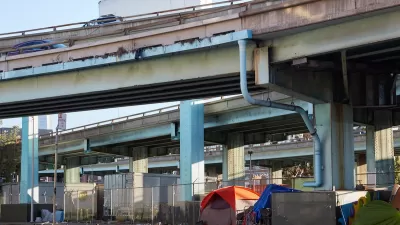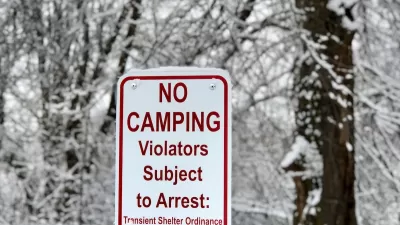An annual reports finds a growing number of homelessness in Utah. That information, coupled with mistakes in earlier reports, casts doubt on the state's record of success in housing vulnerable populations.

"Once lauded as a leader among U.S. cities struggling to relieve homelessness, the number of people sleeping rough in Utah's capital has spiked in the past two years, as funding for its groundbreaking housing programme dried up," reports Gregory Scruggs.
According to the 2015 "Comprehensive Report on Homelessness" [2015] by the Utah Department of Workforce Services, chronic homelessness reduced 91 percent in the state the first half of the decade. That story quickly changed, however. The "2018 report [pdf] said that the number of people sleeping outdoors in the state has nearly doubled since 2016," according to Scuggs.
Utah's earlier track record of success was credited for many years to the "Housing First" policy adopted by the state in 2005. That program, "focused on getting people into housing, regardless of mental illness or substance abuse problems that could be treated after accommodation was secured," explains Scruggs.
Glenn Bailey, who directs Crossroads Urban Center, a Salt Lake City food pantry, is quoted in the article saying Utah's homeless numbers started rising when it stopped funding the program.
But there's also reason to believe that the Housing First program was never as successful as the 2015 homelessness report claimed. Tania Dean reported in December 2018 on an audit from the Office of the Legislative Auditor General: "According to the audit, between state, federal and private donations, $100 million was spent on solving Utah’s homeless issue in 2017. However, auditors don’t know if any of the homeless services provided to decrease the state’s homeless population have been working."
The audit blames "problems with the data and weak management information systems" for the errors in the 2015 report.
Hat tip to YIMBY Wiki for sharing the news about the audit.
FULL STORY: Once a national model, Utah struggles with homelessness

Study: Maui’s Plan to Convert Vacation Rentals to Long-Term Housing Could Cause Nearly $1 Billion Economic Loss
The plan would reduce visitor accommodation by 25,% resulting in 1,900 jobs lost.

North Texas Transit Leaders Tout Benefits of TOD for Growing Region
At a summit focused on transit-oriented development, policymakers discussed how North Texas’ expanded light rail system can serve as a tool for economic growth.

Why Should We Subsidize Public Transportation?
Many public transit agencies face financial stress due to rising costs, declining fare revenue, and declining subsidies. Transit advocates must provide a strong business case for increasing public transit funding.

How Community Science Connects People, Parks, and Biodiversity
Community science engages people of all backgrounds in documenting local biodiversity, strengthening connections to nature, and contributing to global efforts like the City Nature Challenge to build a more inclusive and resilient future.

Alabama: Trump Terminates Settlements for Black Communities Harmed By Raw Sewage
Trump deemed the landmark civil rights agreement “illegal DEI and environmental justice policy.”

Dear Tesla Driver: “It’s not You, It’s Him.”
Amidst a booming bumper sticker industry, one writer offers solace to those asking, “Does this car make me look fascist?”
Urban Design for Planners 1: Software Tools
This six-course series explores essential urban design concepts using open source software and equips planners with the tools they need to participate fully in the urban design process.
Planning for Universal Design
Learn the tools for implementing Universal Design in planning regulations.
City of Santa Clarita
Ascent Environmental
Institute for Housing and Urban Development Studies (IHS)
City of Grandview
Harvard GSD Executive Education
Toledo-Lucas County Plan Commissions
Salt Lake City
NYU Wagner Graduate School of Public Service





























